Over the past few weeks, I've been making a concentrated effort to 'rediscover' my closet, reacquainting myself with my pre-pandemic stylings. Some things I'd completely forgotten about (yay), and some no longer fit (not yay). However, even with my closet in full view, it was hard to remember how I did this.
I found myself wishing I was one of those mirror selfie people; at least then I'd have something to reference. Did I really wear all these underwire bras? Why did I need so many belts, I have no problems with pants falling off now.
I was overwhelmed and needed to find some entry point, some way to start, using small low-pressure, going-out opportunities to practice.
Color theory
It hit me one day while combing Pinterest for outfit ideas, which is is typically a sign I'm getting a bit desperate.
While hardly a new concept, it's just one I'd never really thought about attempting myself before. There are a few names for it, 'monochromatic' style, tonal dressing, color blocking etc., but collectively the approach is to use color to help drive how you get dressed.
Now if you're someone who has a monotone wardrobe already you're in luck, you're already doing it. But if you, like me, are someone who finds yourself with a closet full of clothes in various styles, colors and prints and still have nothing to wear, you might find discover that you may have more to love in your wardrobe than you thought.
Here's a cool interactive online color wheel tool from Canva and here's an image of a color wheel you can save to your phone for handy reference.

Beginner: Monochromatic approach
The place to start. If you've never thought about getting dressed this way before I'll admit it does feel weird. If I end up I head to toe purple would people at the grocery store think I look like Grimace? If I went all yellow should I plan to forgo picking up bananas this trip?
What I learned while doing is that it's actually unlikely that all your clothing items in a color are all exactly the same so the risk of looking like a crayon is less of a risk than I'd originally anticipated.
Monochromatic dressing is basically picking clothing items in a color scheme based on a single base hue like red, green, or circled here, blue.
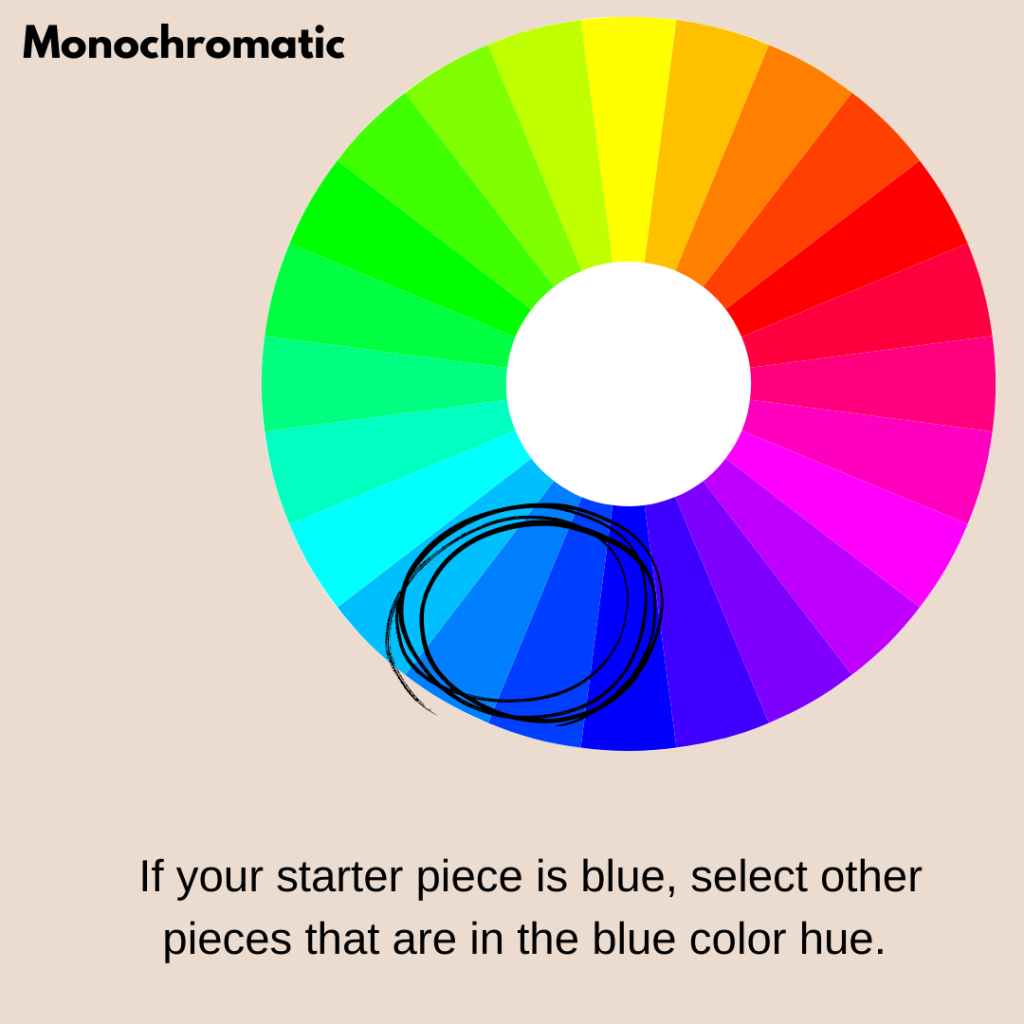
Pretty straight forward but if we had to 3-step step this:
-
Open your closet
-
Select your starter piece
-
Select the next piece based on the color of your starter piece
I have a lot of navy blue so I started with navy blue pants. So with navy blue as my 'starter' color du jour, I'd move onto choosing the next item of clothing. The best part about this approach is that you don't have to worry so much about getting 'matchy'. The tones and shades of the items don't matter as much as you would think as long as they're all of the same base hue, in this case blue. So with navy blue as my starter item, I'd probably look to choose a top also in navy (I have a lot of navy), light blue, cerulean or even royal blue and it would still work.
I realize that sounded this sounds like one of those 'get the perfect winged eyeliner every time with this trick' eye roll step-by-steps so while i'm certainly not promising easy wins without any effort, I do have some tips to share from each step that may help you.
1. Open your closet
-
Unless you've got an expansive walk-in where you're able to see everything you have in view, getting everything out in the open is important.
-
Slide open all doors, pull stacks out, use the bed, the floor, to lay things out and get a sense of your closet in its completeness (or incompleteness).
-
Getting everything out in the open (then putting it away) is probably the most time consuming step if you don't have a lot of space so plan ahead. And keep in mind you don't have any specific goal to achieve in this step, just get started.
-
Take some stock of what you see. Do you have a lot of one specific color? Do you have a lot of the same thing? Sometimes you don't notice unless you get everything out in the open and see it together. Make a mental note.
2. Select your starter piece
-
Try to have fun - Assuming that you are starting off in a low pressure situation (aka going to the grocery store), you can breath easy, we're just messing around, try to have fun.
-
This is not the time to be bold - Pick something that you feel comfortable in (aka it fits). It may be something you've worn recently. The best way to discourage yourself is picking something you would't normally wear ever as part of your-to-day so start with something familiar. It could be the sweatpants you're wearing now but let's try to make some efforts ok?
-
Start with the bigger pieces - don't try to build an outfit around a pair of socks. Start with pants, a skirt, a top etc.
-
What is the color of your starter item - maybe it's obvious but is it one of those colors that's a grey-ish blue or a purpley pink? It matters less which side you pick and more that you pick one so you can move onto the next step.
3. Select the next piece based on the color of your starter piece
-
You're not trying to find a 'match' - don't get hung up on trying to find something in exactly the same color as your starter item, you're not trying to create a 'match'.
-
Just put it on - when you identify something in the same hue, just put it on. Try not to question yourself 'do these two blues go together?' is this too much blue? Just put it on.
-
Mix fabrics and textures - this will depend on where you live but it's ok to mix wool with silk, cotton with corduroy. Remember, the only rule is for the items to be in the same color hue.
-
Try for 2 - instead of trying to get a head-to-toe look, make getting 2 main pieces (a top and a bottom) your goal.
-
Don't forget about outerwear - perhaps you have a coat in a color you really like. Think about how you might use that as your starter item.
-
Denim on denim - If you find yourself struggling with this at the start, you fall back to denim on denim anytime. Pairing any pair of jeans with any denim or denim color shirt seems to just work. And if you don't have a denim shirt, you should try to add one. Like jeans they go with almost everything and are perfect for so many occasions.

Here are some places where you should almost always be able to find a denim number you'll work and that won't break the bank.
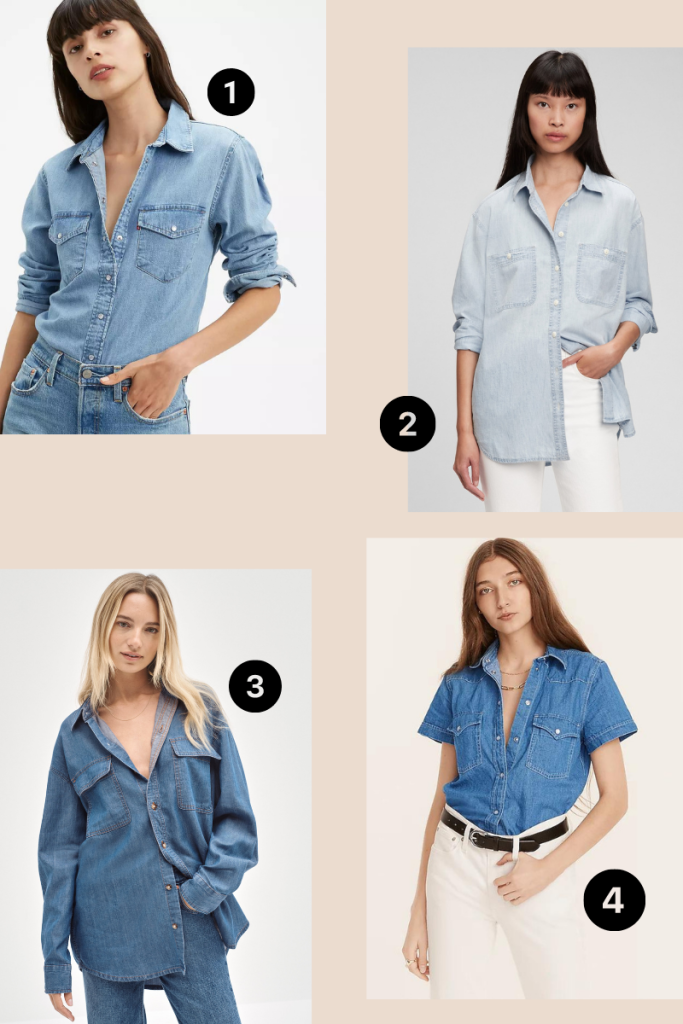
If you're feeling like this could work for you then great. If not fine as well. If you're interested in continuing, the real next step is to wear your newly created outfit out of the house. It's all just make believe if you don't actually leave the house.
Intermediate: Analagous approach
If you feel like you've gotten the hang of the monochromatic approach and want more ways to use color to get dressed here's another.

Instead of staying with just colors all in the same huge, this approach start to incorporate analougous colors to the mix, the colors on either side of your starter hue color. So if you're starter color is blue, bring in pieces in purples or greens. If your starter piece is purple, bring in some purple or blue.
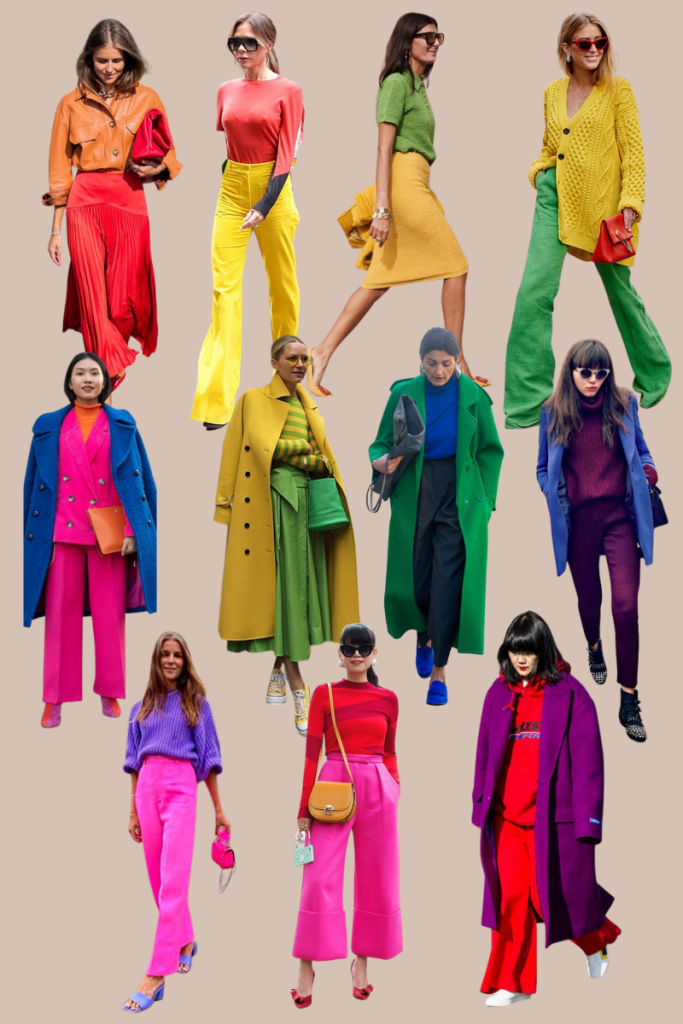
My biggest tip on this approach is to select one analygous color to start. So if your starter color is blue, choose a green or purple, not both. If you're starter color is red, go with a red or a pink, not both.
Advanced: Complimentary approach
I found myself really getting into this and briefly ventured into what's probably less 'monochromatic' and venturing into the realm of 'color blocking'.
The rule of thumb here is opposites attract. Using our handy color wheel here, you're looking for the color immediately across from the color of the item you've chosen as your starter piece.
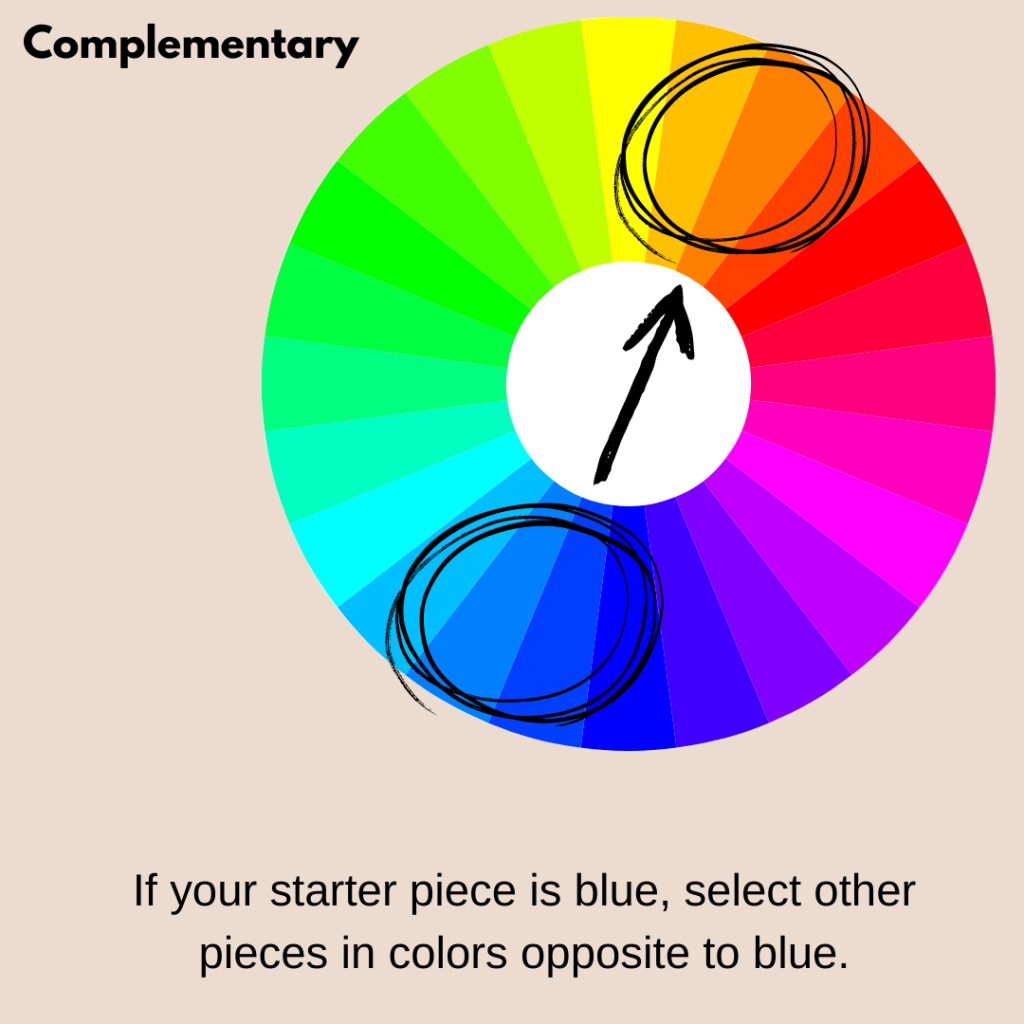
For me personally, I found that this works best when you have clothing items in solid colors that really highlight the 'opposite-ness' of the look. I don't have a lot of clothes that fit distinctly into opposites so I didn't find this approach so successful.
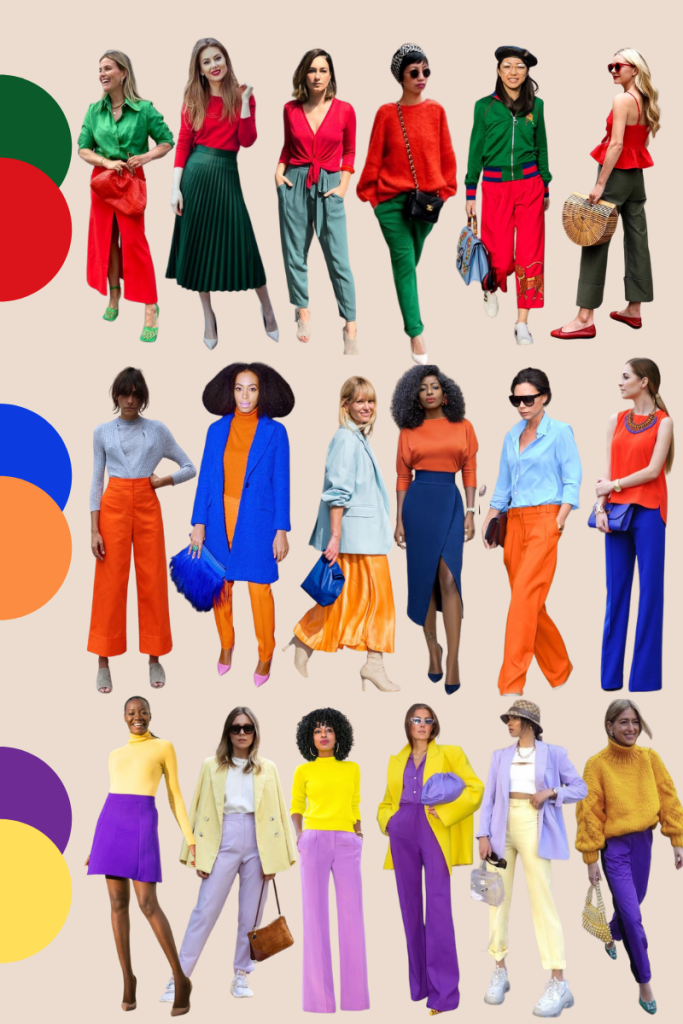
What I did find more successful is building a monochromatic look then using accessories to bring in points of interest It could be a big leather bag, chunky gold jewelry or even a scarf in a great print.
Is all this going to work for you?
Well you won't really know until you try but this is supposed to be fun so it's worth a shot. If anything you'll burn a few calories trying things on. It may also help you do a bit of that closet clean out that's needed from time to time.
So do I go out now everyday in a monochromatic look? For sure no but I definitely do from time to time and found it's less scary than I thought it would be. I do love a good denim cowboy look for sure, maybe you will too.
